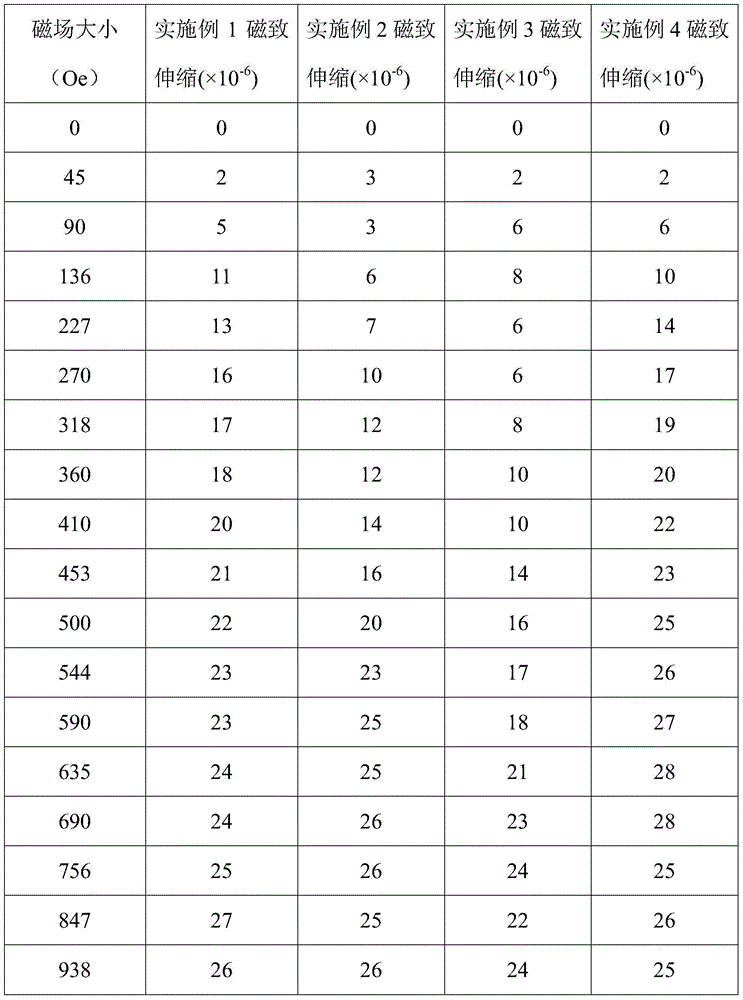Fe-Ni metal-based magnetostrictive material and preparation method thereof
A magnetostrictive material, metal-based technology, applied in the preparation of the Fe-Ni metal-based magnetostrictive material, in the field of Fe-Ni metal-based magnetostrictive materials, can solve the problems of poor magnetostriction and achieve magnetostrictive Good expansion and contraction, grain refinement, and overall performance improvement
- Summary
- Abstract
- Description
- Claims
- Application Information
AI Technical Summary
Problems solved by technology
Method used
Image
Examples
Embodiment 1
[0048] Step 1: Weigh Fe 25%, Ni 46%, Cr 5%, Ti 2.5%, Si 1.5%, Al 0.5%, Co19.5% powder according to the mass percentage, the sum of the weight percentage of the above components is 100 %;
[0049] Step 2: mixing and pressing the components weighed in step 1;
[0050] The specific method is: put each component into the mold and keep pressing for 28 seconds under 28 tons of pressing;
[0051] Step 3: Smelting the alloy from the raw material after pressing in step 2;
[0052] The specific method is:
[0053] Step 3.1: Vacuumize the raw material after pressing and molding in step 2, and the vacuum degree is 1×10 -3 Pa filled with argon until the pressure in the furnace cavity reaches 5×10 4 Pa;
[0054]Step 3.2: Melting for 2 minutes until all components are completely melted;
[0055] Step 3.3: Turn over and repeat the above steps 3 times to make the components of the alloy evenly distributed to complete the smelting of the alloy;
[0056] Step 4: absorbing and casting the ...
Embodiment 2
[0065] Step 1: Weigh the powder of Fe 30%, Ni 40%, Cr 6%, Ti 2%, Si 2%, Co20% according to mass percentage, and the weight percentage sum of the above-mentioned components is 100%;
[0066] Step 2: mixing and pressing the components weighed in step 1;
[0067] The specific method is: put each component into the mold and keep pressing for 30 seconds under 30 tons of pressing;
[0068] Step 3: Smelting the alloy from the raw material after pressing in step 2;
[0069] The specific method is:
[0070] Step 3.1: Vacuumize the raw material after compression molding in step 2, at a vacuum degree of 2×10 -3 Pa filled with argon until the pressure in the furnace cavity reaches 5×10 4 Pa;
[0071] Step 3.2: Melting for 2.5 minutes until all components are completely melted;
[0072] Step 3.3: Turn over and repeat the above steps 4 times to make the components of the alloy evenly distributed, so as to complete the melting of the alloy;
[0073] Step 4: absorbing and casting the al...
Embodiment 3
[0082] Step 1: Weigh Fe 40%, Ni 36%, Cr 4%, Ti 3%, Si 1%, Al 1%, Co 15% powder according to mass percentage, the sum of the weight percentages of the above-mentioned components is 100%;
[0083] Step 2: mixing and pressing the components weighed in step 1;
[0084] The specific method is: put each component into the mold and keep pressing for 32 seconds under 32 tons of pressing;
[0085] Step 3: Smelting the alloy from the raw material after pressing in step 2;
[0086] The specific method is:
[0087] Step 3.1: Vacuumize the raw material after pressing and molding in step 2, and the vacuum degree is 3×10 -3 Pa filled with argon until the pressure in the furnace cavity reaches 5×10 4 Pa;
[0088] Step 3.2: smelting for 3 minutes until all components are completely melted;
[0089] Step 3.3: Turn over and repeat the above steps 5 times to make the components of the alloy evenly distributed to complete the smelting of the alloy;
[0090] Step 4: absorbing and casting the ...
PUM
| Property | Measurement | Unit |
|---|---|---|
| diameter | aaaaa | aaaaa |
| diameter | aaaaa | aaaaa |
| diameter | aaaaa | aaaaa |
Abstract
Description
Claims
Application Information
 Login to View More
Login to View More - R&D
- Intellectual Property
- Life Sciences
- Materials
- Tech Scout
- Unparalleled Data Quality
- Higher Quality Content
- 60% Fewer Hallucinations
Browse by: Latest US Patents, China's latest patents, Technical Efficacy Thesaurus, Application Domain, Technology Topic, Popular Technical Reports.
© 2025 PatSnap. All rights reserved.Legal|Privacy policy|Modern Slavery Act Transparency Statement|Sitemap|About US| Contact US: help@patsnap.com

